Watching tennis on TV
Can you improve your own tennis game ?
There are different ways you can watch a tennis match on TV.
You can enjoy the match. Simply watch the ball (if you can see it ?) and the score, and if the match is a very close one you will be sucked into the drama and suspense as first one player and then the other takes the lead and eventually gets closer to the finish line. There may even be some match points saved by the player who is behind to add to your excitement and to keep the match in even more drama and suspense. Who will win ? When will the match finish ?
However you can become a true student of the game of tennis and improve or perhaps confirm your knowledge of other areas of game and ultimately your own tennis game.
There are four major components in the game of tennis.
Technique, Tactics, Physical section and Psychology.
In any professional tennis match involving any of the top 100 players in the world you will quite probably see all four components in use at some stage of the match.
You the spectator will certainly be able to study the Techniques of the players. Are they different ? Are there any weaknesses.
You will certainly see Tactics being involved; most probably every point.
The Physical section involves much more than just “who is the fittest ?”.
And at this level of play and level of importance regarding prize money and world rankings you will often see clear examples of the Psychological section. Often the pain of the player, the pressure on the player’s emotions with the resultant anxieties become painfully evident. Many matches are won or lost on simply a few moments of loss of emotional control.
An Elite tennis coach must be able to analyze any tennis match. That includes listing and prioritizing the reason why one player defeated another. That includes diagnosing the strengths and weaknesses of each player.
How about you pretend you are in training to become an Elite coach. Your mission is to analyze the current match you are watching on TV. To make your attempt even more professional, turn the volume off and observe the match by watching only.
Lets get back to your normal watching of the match, but with the improved version of your match observations.
In the Technique section, especially watch carefully the slow motion replays . Here you will be able be see all the movements of the pro’s strokes. You may even be lucky enough to get a super slow replay. Try to look for specific items which relate to your own game. That of course involves you knowing your own strengths and weaknesses.
On the serve for example have you learnt that your toss is not far enough forward on your first serve ? Then check very carefully to see how far forward the pros are actually tossing the ball. With luck you may be able to see some shots from the camera taken from the side or on top.
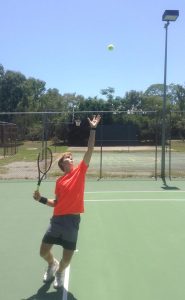
Have you learnt that your service toss is not high enough ? Then check very carefully to see what the pros do. Check several of the pros. Do they all toss at the same height ? (I know the answer to this one….do you ?).
On your forehand, have you been told you do not follow through enough ? If so, then check to see if the pros do finish in Pose 4.
In the Tactical section, continue to appreciate and learn how important consistency is. Why not take twenty minutes of your viewing time and count (and record) the number of hits in each rally ? And obviously record the longest rally for the day. The next item is the one which I see slip under the radar for the average club player. You must have watched a match where there are many long rallies, and to you the players seem to be evenly matched, but…..the score ends up 6-2,6-1 and you say to yourself “but there was nothing separating the players”. So often the match is won and lost in the trenches. In tennis terms there are many parts to in the trenches, but to me, and especially in this day and age of almost nil net attack, the first big area of struggle is to maintain depth. Depth can be referred to as subtle offence. It may not win the point outright like a huge winner, but for sure it will most times hold the opponent off of you, and the first outcome of this tactic will be that the opponent feels frustrated and many times becomes desperate and reckless (in trying to find ways of winning more points). So when you are watching those long baseline rallies look more closely at which player is hitting deeper (on average). And my prediction is that the player with more depth will most times end up winning the match.
Do not think depth applies only to the groundstrokes. Look very carefully at the player’s second serves. Look carefully at volleys, especially any difficult defensive volley. In the past the great serve/volley players absolutely mastered the get out of trouble volley by volleying deep AND back down the line (to eliminate angle for the opponent).
Another key item so often overlooked by the average club player is not realizing what height over the net the pros are hitting (on average). So many club players I see, and especially teenage boys, are thinking that every shot from the pros is skimming the net. This is incorrect; the pros are giving themselves much net clearance.
So I will divert for a moment and list The two biggest disadvantages of watching tennis on TV.
- It is usually difficult or impossible to see the actual height over the net (unless the camera shot is from court level). Most big stadiums have very high stands. Many times the camera is located half way up the stands (directly behind the baseline). This is good for watching side to side movement and ball placement; and quite good for observing depth; but no good at all for trying to observe the height of the ball over the net. The camera is often half way up the stands, which makes it at times the height of an average tree, so the average club player thinks the ball is travelling close to the net as this is what they see.
- Because of the reasonably large distance from the camera to the near baseline, and a larger distance to the net, and an even larger distance to the far baseline, the camera does not display the true speed of the ball. Your eye watching the ball on TV will record a much slower ball than in real life on the court for the pro. You will not be able to fully appreciate how little time the pro has.
Your only way to check this (if you do not fully believe me) is to go to an outside court and watch the pros play there. Watch firstly from just behind the umpire’s chair (checking height over the net); then stand directly behind the receiver and find out how little time there is to react to a fast serve AND hit it back ! If directly behind the baseline is not available, then standing at the corner fence will suffice.
Placement is another big item to observe. Are you thinking about how many hits are going to the opponent’s backhand v their forehand ? Or where does one player hit their backhand ?
The above sketch shows Murray’s backhand placement. Note, this is on grass, at Wimbledon and for his first two matches. Who would have thought he would hit so many to the same place ?
Are you thinking about where most of the player’s serves are going ? Or where do one player’s Aces go ? Or where does one player’s second serve go ? These are the items you should be looking at and even thinking about employing the same tactics in your next match.
And then we need to consider Power. I feel that many club players are obsessed with power. So it is time to make the well known statement…..Power is worthless without control. If you are a teenage boy looking good on the court and hitting everything at 200kph, but one in and nine out, it is time for you to understand that the best thing you can do is to reduce your power hitting and learn to hit more balls in. For this article that is all I will say to that group of players.
Of the other groups there will be some of you who do not hit the ball hard at all. So now is the time to work out why you are not hitting hard. Is it only habit ? Or fear of making a mistake ? Or a technical item in your stroke is incorrect and forcing you to choose to hit the ball softer in order to make sure the ball goes in ? Whatever, perhaps it is time for you to try to solve the problem. Perhaps simply watching the pros and thinking about power will help you solve your dilemma.
One item regarding power would apply to all of you. Kindly observe how the pros use a full range of power. Sometimes full power; sometimes much reduced, sometimes half power, sometimes very little. Your answer to this is to realize that the pros choose a certain ball speed depending on the current situation. Sometimes they change the pace of the ball solely as an item of variety. Some opponents do not like fast balls so the more fast balls you can hit the more points you will win. Some opponents gradually start playing better the harder you hit. Some opponents absolutely hate slow balls.
The following is a good match summary of a Wimbledon final.
Another example of using finesse took place in a Wimbledon
mens singles final between Jimmy Connors and Arthur Ashe. The
report on the match described Ashe as using “junk” and slowing
down the pace of shot making. Ashe refused to get into a
slugging match, which was what Connors excelled at. The report
quotes:
“On paper, this looked like it should have easily been Connors’
match—he was the defending champion and hadn’t lost a set in
the tournament. Oddsmakers made Ashe a 5-1 underdog, and an
even bet to win a single set. But after Connors won the first
game, Ashe simply took him apart. Relying on “junk” to beat the
#1-ranked Connors, Ashe chipped and lobbed his way to 12 of
the next 13 games. His 6-1, 6-1, 5-7, 6-4 victory enabled him to
become the first African American man to win Wimbledon.”
Finesse of course is a very subtle item full of complexities. However to try to get you on the right path for this item you could try checking out the pros hitting lobs and drop shots.
When do the pros lobs ? What is happening to their opponents at that time ? Are you seeing the difference between a defensive lob and an offensive lob ?
When do the pros drop shot? Besides delivering the ball short, which side of the court do they drop shot to ? Where are the pros standing on the court when they drop shot ?
These are all important items for you to study.
The Physical section has much more in it than first meets the eye. Obviously we talk about general fitness, stamina and how long a match may last or how many kilometers the players will have to run.
But beyond those items are other critical items which so often affect the results of the match, and for myself I listen to what the pros say about themselves. If the pros say that “ Sam Stosur has the most difficult second serve to return”, then I believe them. (This was simply an example I plucked out of my imagination). I place great trust in any general consensus from the pros themselves. So who do you think the pros claim to be the fastest woman and man around the court ? Do you know ? If not then perhaps this would be a good item to study carefully whilst you are watching the matches on TV. The pros say Serena Williams and Andy Murray are the fastest around the court.
Any item which you see the pros excelling at is an item which you probably should be trying to improve.
How fast can you run ? Can you improve your quickness (this is not the same as speed) ? How high can you jump from a standing start ? Are you flexible enough ? Should you be taking yoga classes ? Do you have enough body strength ?
And then we have footwork !! (I love this one).
Footwork starts with the ready pose (pose 0). Have you perfected that pose ? Do you look the same as the pros when they are in Pose 0 ?
Do you take many little steps before you hit the ball ? (Get some old clips of Agassi and study his footwork).
Do you recover the same as the pros ? Immediately and almost in a frenzy , like the pros, or are you recovering like you are at a picnic social tennis game ?
Psychology
This section is always so complicated….and a minefield ( and yes also a mind-field haha).
I guess a starting point for you in this discussion is for you to ask yourself if you fully understand In the Zone and In the Now (same thing).
Very briefly it means controlling your emotions enough so that you do not react to any single external happening…..except the ball.
So your TV exercise would be to see if you can observe any of the pros reacting to anything apart from the ball. If you watch enough matches carefully you will see the pros (usually under pressure) lose it !
Classic examples are : John McEnroe and his tantrums. Margaret Court v Billie Jean King at Wimbledon where Margaret hit the worst second serve ever. (Terrible toss, ball hit the throat of the racket, ball landed in service box this side of the net). Serena Williams abusing line umpire. Jana Novotna losing Wimbledon having had a huge lead and saying “I volleyed well”; she missed an easy forehand volley into an open court to give her the title. Goran Ivanisevic finally winning Wimbledon after many attempts and choking on his serve when the end was in sight. He choked so badly he could not get a first serve in, hit some terrible mishit second serves which fluked their way in, added several double faults and unbelievably Pat Rafter made some horrible returns on weak second serves at the wrong time (choked). Goran went on to win a match he should have lost. Sam Stosur losing in the final of the French (and not playing well) against a player she had recently beaten.
In my book Tennis with Passion I explain that hitting the ball in becomes easier if you are In the Zone. If you are not In the Zone the ball speeds up and you become rushed. When you are In the Zone the ball slows down and becomes larger, so much so that you cannot miss that shot !
See sketch below.
So from now on the choice is yours. You can have your strawberries and cream and peacefully observe the ball travelling from one racket to the other, and perhaps occasionally get really excited over the score.
OR you can become a true aficionado of the game of tennis.
Good luck. You can do it !
Alan Lane.

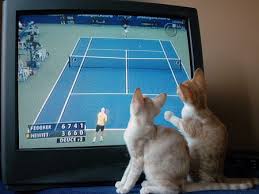
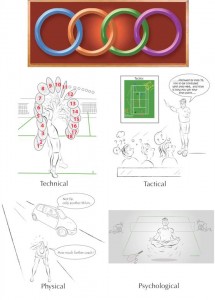
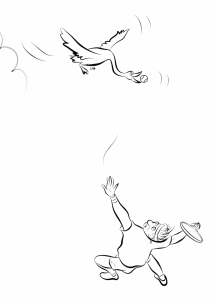
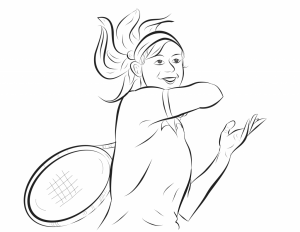
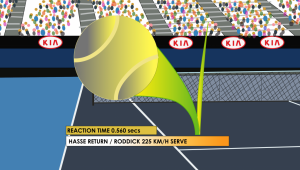
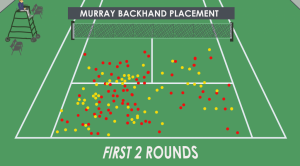
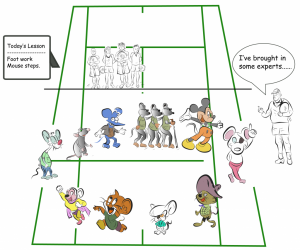
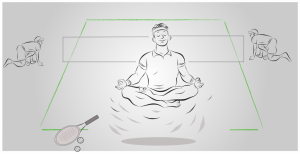
![Sketch PSY2-revised2[1] Final](http://perfectlesson.com/wp-content/uploads/sites/3/2016/01/Sketch-PSY2-revised21-Final-300x177.png)
Recent Comments